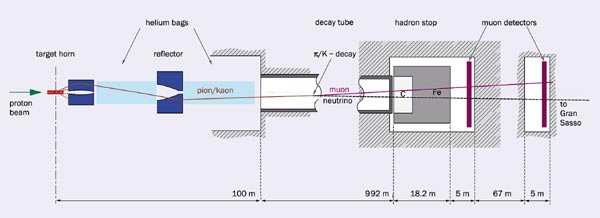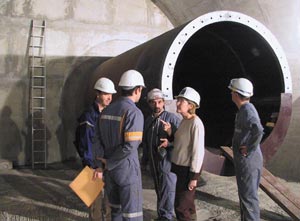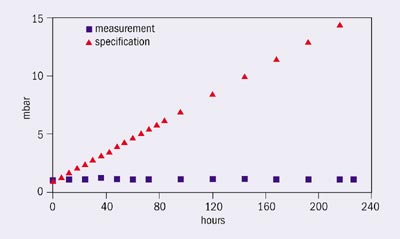The CERN Neutrinos to Gran Sasso (CNGS) project is set to deliver its first neutrinos in spring 2006. A key element is the vast decay tube.

When CERN’s Super Proton Synchrotron (SPS) starts up its scheduled run for 2006 it will be continuing the laboratory’s long tradition of experiments with neutrino beams, exemplified by the discovery of weak neutral currents in Gargamelle. However, in this case the neutrinos will not be destined for detectors at CERN, instead they will be travelling 730 km to the Gran Sasso underground laboratory in Italy, 120 km east of Rome. There is now unambiguous evidence from solar and atmospheric neutrino experiments that neutrinos can “oscillate” – change from one type to another. The aim of the CERN Neutrinos to Gran Sasso (CNGS) project is to investigate this phenomenon further, over a completely different range of energies and distances. Its muon-neutrino beam will be tuned to produce a maximum number of neutrinos per year with a neutrino energy spectrum best suited to the search for muon- to tau-neutrino oscillations.
The CNGS neutrino beam will originate when 400 GeV protons, extracted from the SPS, strike a graphite target to create pions and kaons. The muon-neutrinos produced in the decays of these particles will form the beam directed towards Gran Sasso. A key component of the beam line is therefore a vacuum tube, with a diameter of 2.45 m and length of 1 km, in which the particles decay. The tube passed its vacuum tests at the end of April this year, an important milestone for the overall project.
The decay process has a natural angular spread; even a perfectly aimed pion beam would still produce a neutrino beam with a large angular divergence. In the case of CNGS the neutrino beam arriving at Gran Sasso will have a radius of about 750 m (1σ). Although this is very large compared with the detector size, it is still important to aim the beam at the detectors at Gran Sasso as accurately as possible. Using the most advanced geodetic techniques, including GPS positioning, the CERN survey team wants to “hit” the target with an error better than 50 m. Since the decay tube acts like a collimator for the neutrino beam, the accuracy with which this tube is put in place is crucial.
In order to aim at the Gran Sasso laboratory, the CNGS facility at CERN – the last section of the proton beam line, the production target, etc – is built on a vertical slope of 5.6% and the decay tunnel passes some 12 m below the tunnel of the Large Hadron Collider (LHC). It was therefore decided in December 2001 to drill a vertical hole down from the LHC tunnel at exactly the position at which the decay tunnel should be located. The first qualitative success occurred on 4 March 2002, when the machine boring the decay tunnel indeed passed below this point. Later measurements showed that the tunnel was accurately located to within a few centimetres. The remaining errors were corrected during the installation of the decay tube inside the tunnel.

Why did the project opt for a decay vacuum? The aim is to have as intense a muon-neutrino beam as possible, and if a maximum number of pions and kaons are to be left “free” to decay, without interaction, it is important to have a minimum amount of material in their path. A decay tunnel with air would have resulted in a 28% loss of particles as compared with a vacuum tube; a tube filled with helium would have led to a 7% loss and would still have required a vacuum chamber to evacuate the air first and contain the helium.
The decay tube itself is a 992 m long steel tube, 2.45 m in diameter and 18 mm thick: it is allegedly the largest standard diameter used in the oleoduct (oil pipeline) industry, and a larger size would have produced little gain in neutrino intensity. The chosen length of 992 m conveniently takes the decay tube beyond the LHC tunnel. A much longer decay path would have produced 20-30% more neutrinos but with a significantly higher fraction of unwanted neutrino species in the beam, and the extra cost would have been prohibitive. Studies showed that with a wall thickness of 18 mm throughout and no anchoring points the tube has enough rigidity to withstand the external air and hydraulic pressures and the effects of beam heating.
At CERN the preparations for CNGS have involved the excavation of some 3 km of new tunnels plus several caverns. The first phase of civil engineering was completed in 2003, with the handover of part of the tunnels from the contractors on 1 August. While excavation work had finished in December 2002, concreting the various caverns, which began in 2002, and the 1.7 km of tunnels took a further 6 months – requiring some 12,000 cubic metres of concrete.
The decay tunnel was excavated by a tunnel boring machine at a diameter of 3.7 m. As the tube itself is 2.45 m in diameter there were two options for installation – leaving the tube in air, which would require steel thick enough to withstand pressure and temperature differences, or embedding it in concrete, in which case the concrete prevents buckling and provides some thermal contact between the “hot” steel tube and the “cold” rock surrounding the tunnel. The option of embedding the decay tube in concrete was chosen as it allows the use of a thinner walled steel tube and gives the best cost/quality ratio overall.

Before the decay tube could be installed, the components of the beam dump had to be transported to the end of the tunnel and assembled. The installation of the “hadron stop”, or beam dump, was completed in September 2003. Resembling a three-dimensional “puzzle”, the hadron stop consists of more than 400 iron blocks, 76 graphite blocks and 12 aluminium cooling plates. With a total weight of about 2000 tonnes, it is intended to absorb all particles other than the neutrinos and the muons produced with them. The iron blocks were recuperated from the former West Area Neutrino Facility on CERN’s Meyrin site.
The decay tube was constructed from metal sheets that were rolled and welded into 6 m long sleeves by a contractor in Italy, before being transported to CERN. With two sleeves per lorry, there were 85 lorry loads altogether. Once at CERN the sleeves were lowered via a 55 m deep shaft into an access gallery and transported 650 m to the “target chamber”, where they were welded into sections 18 m long. The welds were then tested visually, with dye for weld penetration, using ultrasound and radiography, before each 18 m section was transported on rails into position in the decay tunnel. Finally the section was aligned and welded to the existing tube, and after further tests of the welding, concrete was injected to seal the tube to the rock of the tunnel. A total of 3.6 km of welds, including those made at the factory, was needed to complete the decay tube. The results of the quality checks are impressive: faults found (and repaired) were at the level of less than 1% of all the welds.
Installation of the decay vacuum tube began on 18 November 2003. Once the initial difficulties had been overcome, it took 24 hours to complete each 18 m section. The full installation was finished on 16 March 2004, and on 1 April the tube was closed ready for pumping down and vacuum testing. The tube sleeves had arrived rusty and humid, but with the aid of a ventilation system, by the time of pumping down the tube was dry, if still rusty. It was then evacuated to less than 1 mbar, sealed and monitored continuously for 10 days. Throughout the test period the pressure remained stable, never exceeding 1.3 mbar. Such a good result was a pleasant surprise: the tube walls must be smoother than expected with very little absorption of water or gas as virtually no outgassing was observed.

Completing the vacuum volume are the entrance and exit windows, designed and built at CERN. For the central part of the entrance window, where beam interactions must be kept to a minimum, a 3 mm thick titanium window with a diameter of 1.45 m will be used, somewhat larger than the useful beam size at this point. This is currently being built, for installation in January 2006, so a temporary window of 50 mm steel has been installed for the vacuum tests. At the far end of the decay volume, where losses due to interactions are not so critical, a 50 mm thick steel window has been chosen and installed.
All in all the CNGS project is well on course for the scheduled first delivery of neutrinos to Gran Sasso in spring 2006. Meanwhile, progress is being made on the two major experiments, OPERA and ICARUS, that will intercept the neutrinos.
At Gran Sasso installation of the magnetic spectrometer of the first of two “supermodules” for the OPERA experiment was successfully completed in June, with installation of the target section starting in September. The magnet and target section of the second supermodule will be completed in June 2005 and December 2005, respectively. The first supermodule will be fully filled with emulsion bricks by the time of the first beam in May 2006, while the filling of the second one will be completed during the 2006 run.
At the same time, after several years of R&D, the ICARUS experiment, which acts as an “observatory” for the study of neutrinos and the instability of matter, is coming together. In the summer of 2001 the first module of the ICARUS T600 detector successfully passed a series of tests on the surface. This module should be installed at the Gran Sasso laboratory this autumn. An increase in detector mass by the addition of further modules is foreseen and should be ready to receive the CNGS neutrino beam when it starts up.





